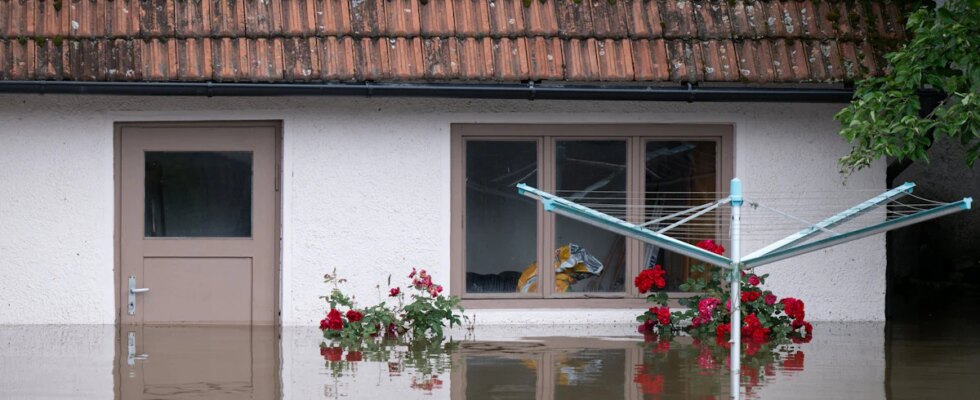The house is damaged, the household goods are just rubbish. The floods are currently affecting hundreds of thousands of people, especially in southern Germany. Cleaning up, repairing, organizing emergency accommodation – it’s hard to know what to do first. Insurance is not the top priority. Nevertheless, victims should take care of it immediately, otherwise they risk losing considerable sums of money.
In the event of a claim, insurance customers must notify the insurer immediately. “In order to receive the money quickly, the damage should be reported to the insurer as soon as possible, even before orders are placed with tradesmen or car repair shops,” says Kathrin Jarosch, spokeswoman for the German Insurance Association GDV. Tenants must contact their landlord quickly in the event of a claim.
Julia Alice Böhne, spokesperson for the consumer protection organization Bund der Versicherten, recommends that the report be made to the insurer in writing. “It is also advisable to contact the insurer’s claims department by phone first.” Victims then usually receive a claim form and direct instructions that they must follow. In any case, they need the claim number and the name of the claims handler.
The best way to document the damage is with photos, explains the GDV spokeswoman. Purchase receipts – if they survived the flood – can also be helpful, as they usually make it easier for the insurer to settle the claim. In the case of flood damage, it is important to record the entire flood, i.e. the insured property or all affected rooms, advises the Bavarian Insurance Chamber. It is also advisable to take photos of the places where the water has penetrated, for example the basement window, says the Munich-based insurance company.
After a storm, homeowners must ensure that the damage does not become even greater. “Insurance holders have a so-called duty to mitigate damage,” says Böhne from the Association of Insured Persons. They are required to take emergency measures to prevent consequential damage, such as sealing broken windows or putting household items in the basement as safely as possible so that the damage does not become even greater. “However, you should never put yourself in danger in the process,” she stresses.
The insurer may obtain an overview of the damage
If damage needs to be repaired before a damage report is drawn up because the house would otherwise be uninhabitable, this should definitely be discussed with the insurer beforehand. It is also important to document how the damage was repaired and to keep the relevant invoices from tradesmen. The same applies if the injured party wants to dispose of damaged parts.
“The insurer is entitled to examine its obligation to pay benefits to the extent necessary,” says consumer advocate Böhne. This means that the company has the right to get a comprehensive impression of the damage. Therefore, the damage pattern must remain unchanged until the insurer allows the customer to change it. “If it is not possible to leave the damage pattern unchanged, you should document it with photos and keep the damaged items in another place.” When taking photos of the damage, the insured should also never put themselves in danger.
It is important that the insurer cannot accuse the customer of a so-called breach of duty: If the policyholder simply repairs the damage without consulting the insurer and later only presents the invoice, the insurer can reduce its payment in the event of such a so-called grossly negligent breach of duty. If the customer commits an intentional breach of duty, the insurer is even released from the obligation to pay.
The insurer covers the costs of damage reduction or damage prevention, but not to an unlimited amount. “Insurers usually have maximum limits that relate to the respective mitigation or prevention measures,” says Böhne. “It is best to clarify directly with your insurer which measures they will take to avoid trouble.”
However, insured persons are generally entitled to reimbursement even if the measure was not successful. If, for example, the sandbags were not able to prevent water from entering the house, they are still entitled to have the costs of the sandbags covered by the insurer.
Whether the insurance pays out for flood damage depends on the policy: While the building insurance covers storm and hail damage to the house and the contents insurance covers damage to household goods, damage caused by heavy rain is only covered if the building or contents insurance also includes natural hazards cover. “It covers the pumping out and drying out and, if necessary, the costs of demolishing and rebuilding the house,” says expert Jarosch from the GDV. The same applies to household goods damage caused by heavy rain: it is only covered by the contents insurance if the policy includes natural hazards cover.
According to the GDV, only 47 percent of homeowners in Bavaria are insured against natural hazards such as heavy rain and flooding. The state is therefore still below the national average of 54 percent.

